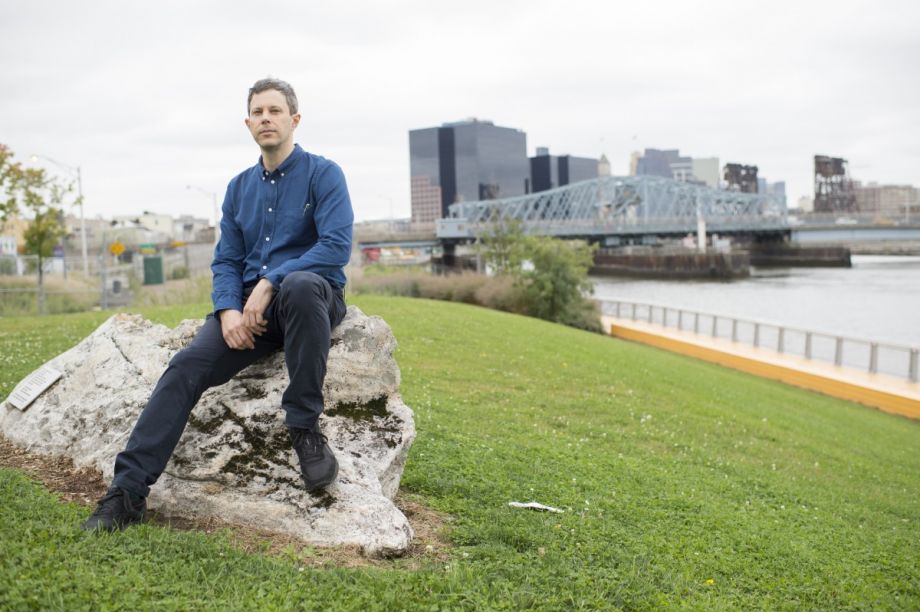Newark, New Jersey’s color palette is brick red and concrete gray, so it’s hard to miss the Day-Glo orange walkway that hugs the city’s riverfront park. It appeared in 2013, when Damon Rich, as Newark’s director of planning, oversaw the opening of the park’s second phase. (Phase three is now under development.) This week, Rich received one of the MacArthur Foundation’s annual “genius grants” for his work in democratizing and demystifying urban planning and design. And though The New York Times sniffed that the walkway’s color was “not ideal,” its bold design speaks to the playful spirit that earned Rich the coveted award.
“There’s a growing list of stories people have brought to this thing,” he says of the orange path. Some alumni of Princeton University, which graduated its first class in Newark in 1748, saw it as a clever reference to the school’s official colors. Others thought it symbolized Agent Orange, manufactured in Newark (and dumped in the river) during the Vietnam War. One yoga instructor who teaches classes in the park informed Rich that orange is the chakra color for water. “It’s physical form paints a picture of people making the place their own.”
Rich has dedicated his career to creating environments in which city residents can discover a personal connection to the most mundane aspects of urbanism. To this end, he’s engaged artists to create eye-catching posters explaining urban policy issues, and helped high school students build models depicting subterranean urban infrastructure. In all cases, the unifying goal is to bring a little colorful flair to the often monochromatic business of running a metropolitan area.
“For me,” Rich says, “what’s so exciting about the recognition from the MacArthur Foundation is the opportunity to speak up and say, look, you might have been told that planning hearings are where design goes to die, but these are actually amazing systems.”
Selected for their creative pursuits and awarded $625,000 each, several of this year’s 24 MacArthur Fellows do work that intersects with the field of urbanism. Kate Orff, a landscape architect, redesigns public spaces to reveal the ecological systems beneath. Rami Nashashibi fights urban poverty by cultivating links between racial and religious groups. Others create paintings inspired by globalization, study transnational migration patterns and analyze social networks in an attempt to reduce segregation.
Rich endeavors to foster not only an understanding, but an actual appreciation of lumbering public sector bureaucracies. In architecture school, he says, zoning and building codes were treated as necessary evils. “Maybe one semester out of three years, you are asked to consider how your project would exist next to other buildings,” he says. It wasn’t until he was out in the real world, meeting with tenant advocates and community organizers, that he began to see these regulations as milestones on the road to civic progress. “It was a real revelation to me that these things weren’t tyrannical constraints,” he says. Quite the contrary — they were the end result of hard-won battles for social justice.
In 1926, in its first major case about zoning, the Supreme Court found that the town of Euclid, Ohio, could regulate what type of development to allow on private land. Cities had implemented ad hoc statutes curtailing dangerous or bothersome development before, but the Euclid case codified zoning as a standard instrument of city governance. The decision was handed down at a moment when pollution, automobiles and suburban sprawl were beginning to transform the very concept of what cities were, prompting the justices to rule that “under the complex conditions of our day,” cities must be allowed to exert influence over their own growth. “In a changing world,” wrote the majority, “it is impossible that it should be otherwise.”
Nearly a century later, such regulations continue to provide a counterbalance to purely capitalistic real estate interests (Houston and other cities excepted). “People had to educate me to see these [regulatory] legacies as the outcome of a grueling effort to make democracy part of how we make decisions about how we build,” says Rich.
He understands as well as anyone, however, that these rules and processes aren’t always beloved — that’s the very reason he works to engender a sense of gratitude for them. “It’s true, you go to most planning meetings, you might see people who seem like they’re hearing aficionados,” he says. “You might find it to be a stultifying ritual. It’s presented in a packaging as deadening as one could imagine. In whose interest is it for these processes to seem boring, antiquated, out of touch, or only the domain of complaining people?”
To change this, in 1997 he founded the Center for Urban Pedagogy, which became the framework for many of his de-stultifying efforts; its work continues to this day. More recently, Hector, the independent design studio Rich co-founded, led the drafting and implementation of Newark’s zoning revamp, the first such overhaul in 50 years. Emphasizing accessibility, the revision included popular education tools and programs to bring constituencies together and make an often cryptic process more inclusive. He also designed a playful exhibit that uses the Queens Museum’s panorama of New York to decrypt and deconstruct the housing crisis for the general public. Presented in 2009 in the wake of the real estate crash, it leveraged large-scale installations and “Sesame Street graphics” to explain an event that, even as it touched the lives of millions, was caused by obscure systems understood by few. In this way, the exhibit’s use of bright colors and friendly design put it firmly in line with Rich’s philosophy that complexity needn’t be boring.
Though he’s not ready to say how he’ll spend the grant money, it’s safe to say it will reflect what Rich calls “an agenda that faces out from our field of architects, planners and designers.”
“I hope that this recognition from the foundation underlines how, even though we come from a strong tradition of thinking about the role of democracy in design,” he says, “we’re still at an early point of what I believe will be a very long arc.”

Will Doig was formerly Next City’s international editor. He's worked as a columnist at Salon, an editor at The Daily Beast, a lecturer at the New School, and a communications staffer at the Open Society Foundations. He is the author of High-Speed Empire: Chinese Expansion and the Future of Southeast Asia, published by Columbia Global Reports.












